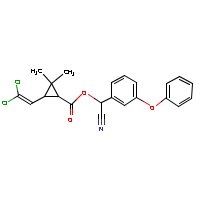Cypermethrin
Agent Name
Cypermethrin
CAS Number
52315-07-8
Formula
C22-H19-Cl2-N-O3
Major Category
Pesticides

Synonyms
(+)-alpha-Cyano-3-phenoxybenzyl-(+)-cis,trans-2,2-dichlorovinyl-2,2-dimethylcyclopropanecarboxylate; (+-)-alpha-Cyano-3-phenoxybenzyl 2,2-dimethyl-3-(2,2-dichlorovinyl)cyclopropane carboxylate; (+-)-alpha-Cyano-3-phenoxybenzyl-(+-)-cis,trans-3-(2,2-dichlorovinyl)-2,2-dimethylcyclopropane carboxylate; (RS)-alpha-Cyano-3-phenoxybenzyl (1RS)-cis,trans-3-(2,2-dichlorovinyl)-2,2-dimethylcyclopropanecarboxylate; 3-(2,2-Dichloroethenyl)-2,2-dimethylcyclopropanecarboxylic; acid cyano(3-phenoxyphenyl)-, methyl ester; AI3-29295; Agrothrin; Ambush C; Ambush CY; Ammo; Ammo (pesticide); Antiborer 3767; Ardap; Arrivo; Asymmethrin; Barricade; Barricade (insecticide); Barricade 10EC; Basathrin; Beta-cypermethrin; Chinmix; Colt; Creokhin; Cyano(3-phenoxyphenyl)methyl 3-(2,2-dichloroethenyl)-2,2-dimethylcycloptopanecarboxylate; Cyano(3-phenoxyphenyl)methyl 3-(2,2-dichlorovinyl)-2,2-dimethylcyclopropanecarboxylate; Cymbush; Cympa-Ti; Cymperator; Cypercare; Cyperco; Cypercopal; Cyperil; Cyperkill; Cypermethrin; Cypermethrin-25EC; Cypermethrine; Cypermethrine [ISO-French]; Cypermetryna [Polish]; Cypersect; Cypor; Cyrux; Demon; Demon TC; Drago; Dysect; EXP 5598; Ecofleece Sheep Dip (Non-OP); Ectomin; Ectopor; Excis; FMC 30980; FMC 45497; FMC 45806; Fenom; Fenom (pesticide); Flectron; Fury; Fury Insecticide; Hilcyperin; JF 5705F; Kalif Super; Kordon; Kreokhin; Mustang; NRDC 149; Neramethrin; Neramethrin EC 50; Nurele; Nurelle; PP 383; Polytrin; RU 27998; Ripcord; Rycopel; SF 06646; Sherpa; Siperin; Supercypermethrin; Supercypermethrin forte; Topclip Parasol; Toppel; Ustaad; Vucht 424; WL 43467; WL 8517; Wrdc149; YT 305; Zeta-cypermethrin; beta-Cypermethrin; cis-Cypermethrin; [ChemIDplus]
Category
Pyrethrins/Pyrethroids
Description
An emulsifiable concentrate or wettable powder composed of a mixture of eight different isomers; [EXTOXNET]
Sources/Uses
Pyrethrins are insecticides used mainly in households; Also used to kill insects on pets and in grain storage bins and poultry pens. Dusts containing 0.3% to 0.5% pyrethrins are used on crops. [EXTOXNET]
Comments
Classified as a Restricted Use Pesticide because its toxicity to fish; Moderately toxic by dermal absorption or ingestion with an oral LD50 in mice that varies from 82-779 mg/kg depending on the mixture of isomers; Causes liver changes in animals fed high doses; [EXTOXNET] Pyrethroids have low toxicity to humans after dermal exposure. Of 573 dermal or ingestion poisoning cases in China, 51 patients had disturbed consciousness and 34 had seizures. Of those, only five were occupationally exposed. Seizures are more commonly related to exposures to fenvalerate, flucythrinate, cypermethrin, deltapermethrin, and fluvalinate. Seizures have not been reported after exposure to permethrin. Pyrethroids may also cause paresthesias after skin contact. Paresthesias (stinging and numbness) usually begin 1-2 hours after contact and resolve within 24 hours. [EPA Pesticides, p. 87-8] Pyrethrins cause liver injury when fed to animals at high doses. [EXTOXNET]
Reference Link #1
Biomedical References
Exposure Assessment
Vapor Pressure
3.07E-09 mm Hg
Reference Link #2
Adverse Effects
Neurotoxin
Other CNS neurotoxin
Hepatotoxin
Hepatoxic (a) from occupational exposure (secondary effect) or (b) in animal studies or in humans after ingestion
Diseases, Processes, and Activities Linked to This Agent
Processes
Industrial Processes with risk of exposure: